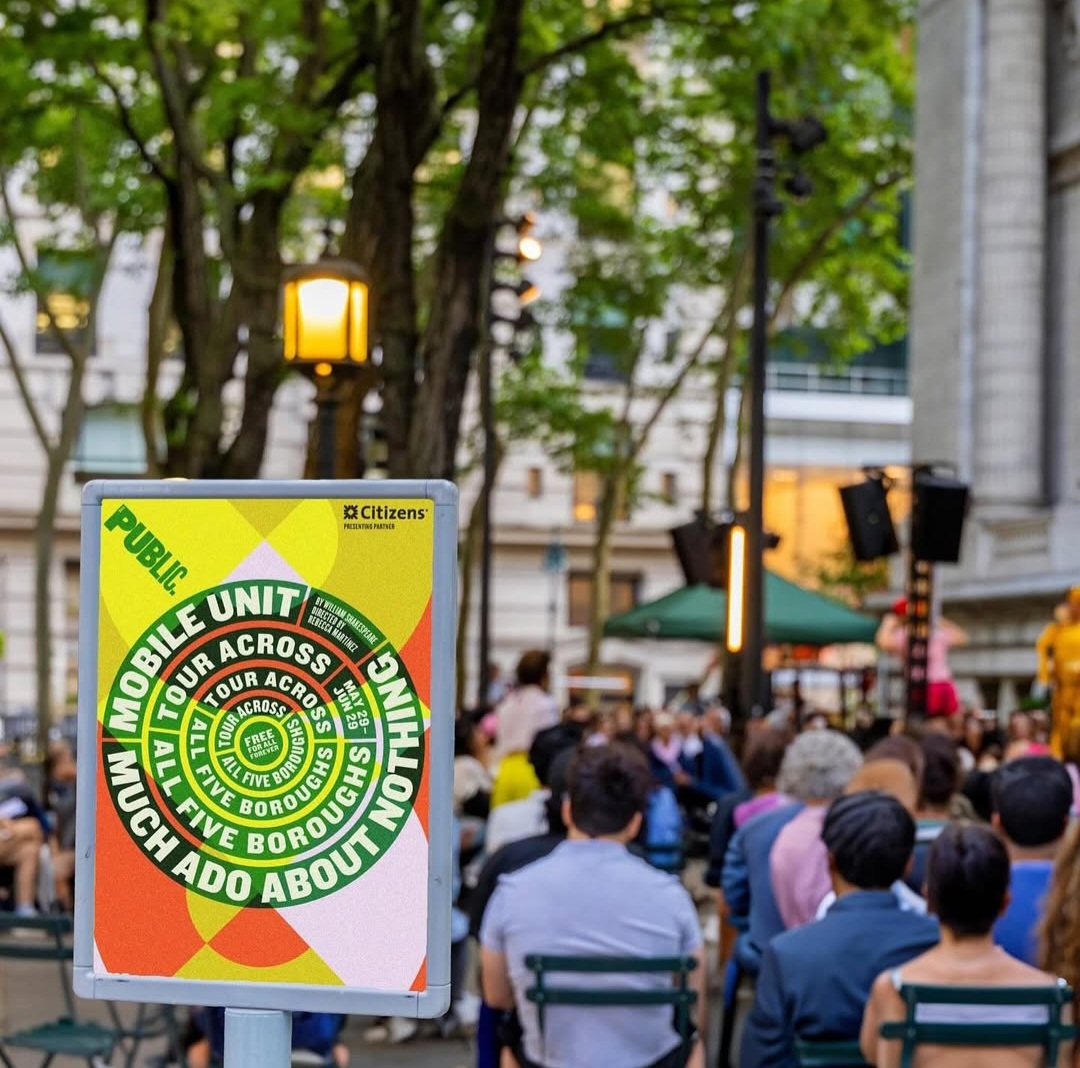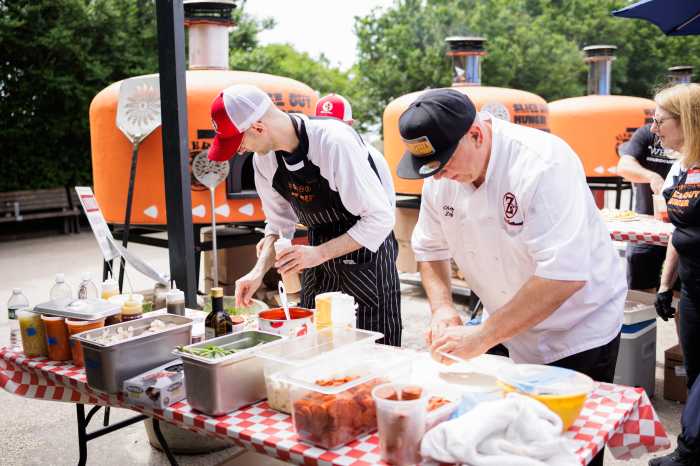
BY JOSH ROGERS | “This is what happens when you take so long to build something,” John Fratta told Lawrence Mauro last week, drawing knowing laughter in the room.
Perhaps it was gallows humor — they were after all talking about the South Street Seaport Historic District, namely the plaza area at Peck Slip between South and Water Sts. The half-acre spot in the middle of the wide street has been slated to be a public gathering place for just over a decade.
What sort? A park, a piazza, a reflecting pool have all been ideas kicked around.
The west end of the plaza opened earlier this year on a temporary basis with tables and chairs and a Citi Bike stand, and the larger east end is scheduled to reopen Mon., Oct. 6 after two successive Sundays of paving work, weather permitting.
But what gets permanently built there once again looks to be an open question.

Back in 2007, Community Board 1 concluded an “extremely painful and long process,” as Mauro recalled it, to hash out what would go there. (“Very tortuous” was another Peck Slip veteran’s memory.)
Mauro, then and now, was overseeing the project for the city Parks Dept. Seven years ago, more board members favored adding lots of trees and green space to the plaza, although there was some local opposition to “cute-ifying” the rustic historic street, where trucks served the Fulton Fish Market in more recent decades, and where ships slipped in to dock with their catch until two centuries ago. Those critics were backed by the mighty SHiPO, the State Historic Preservation Office. SHiPO pushed for no trees in order to help keep the historic area’s feel.
Eventually a compromise was reached to add some trees to the plaza and decorative pieces reminiscent of a ship’s ribs — an element which doesn’t seem to have much support. The project was put on hold for many reasons, including to allow for underground work by other city agencies.
Cut to last week’s meeting of C.B.1’s Seaport Committee, where lo and behold, the consensus seems to have shifted to SHiPO’s idea of a sparse open space plaza.
The original tree advocates were less passionate, and those who always favored a piazza were joined in support by relative newcomers to the neighborhood, who say doing less on the plaza would not only be truer to history, it would better serve the new Seaport, which now has nearby schools open or under construction, and more families.
“You can see now the great majesty of the piazza as SHiPO once advocated,” Gary Fagin, who has lived nearby for 28 years, said at the meeting. “I would implore as much as anyone who has invested a lifetime in this neighborhood can, to see if Parks Dept. can reevaluate as much as feasible the design…to maximize the open space.”

Fagin has helped lead Seaport preservation efforts over the last two decades, and was on the community board in the late ‘90s and early ‘00s, prior to the first Peck debate.
Later in a phone interview, he said his “heart sinks” when he sees other Lower Manhattan slips that have been filled up with too many things. He said changing Peck Slip would be a “mistake of historic proportions. We should maintain the last open slip on the East River.”
The slips numbered about a dozen and were all in Lower Manhattan along the East River, including on Wall St. They allowed vessels to pull in closer to unload cargo and were all paved over by 1859, according to several online historical accounts. Peck Slip stopped taking ships about 1810. Others that remain include Coenties, Catherine and Burling Slips.
Jason Friedman, a newer board member who enjoys sitting in the plaza with his son, is also an architect who has experience with SHiPO. “A lot of times they get things wrong, but here it is absolutely most appropriate both financially and aesthetically that this park not receive trees and these crazy lights from the future,” he said. “It should just be more cobblestones, bollards just like piazzas in Italy, Paris and all of the places that have piazzas.”
He said scaling back the design would not only better serve the neighborhood, it would also save on maintenance costs as well as some of the almost $4 million committed to the project.
Mauro from Parks had been hoping to have a final design soon, contracts signed early next year and construction starting in the summer. He cautioned that any changes now, even building fewer things, would mean a drawn-out redesign and approval process.
“I would have to negotiate that back through my own agency,” he said. “It would have to go back to Landmarks [Preservation Commission], back to SHiPO.”
And the tree support is far from dead, just a little less intense. Board member Joel Kopel expressed concern about providing another space for skateboarders to take over, and afterwards said of the trees, “I don’t see the problem with it.”
Joe Lerner, another longtime board member, who still backs the trees, said, “I don’t want the space for soccer.”
The idea of children playing soccer in the plaza has reached a sort of legendary status in little time. Apparently, it happened at least a few times this year before the Citi Bike docks were installed a few months ago, according to several neighbors. The piazza proponents often cite it as an example of what can be done with more space, but it’s not clear if there are any pictures of it.
The tables and chairs at the plaza’s west end are managed by the Old Seaport Alliance, a neighborhood business group which also backs more open space at the plaza. The Blue School, a nearby private school, is in favor of the piazza. Peck Slip School, a public K-8, will overlook the plaza when it opens its permanent space next year.
John Fratta, the Seaport Committee’s chairperson, said, “We’ve been waiting for this park to be built forever,” he said. “If you really want to go back and start from scratch we are looking at another eight years before we see anything over here.”
But one person whose view may have changed is Paul Goldstein, who helped mediate the dispute back when he was the community board’s district manager. He was quoted in a 2006 Downtown Express article, saying, “We’ve waited this long, so if we have to wait another few months to get it right, we think that makes a lot of sense.”
He still lives nearby and attended last week’s meeting as a representative of Assembly Speaker Sheldon Silver. He said since the community has begun to use the space well, there is little harm in taking the time to scale back the design.
“An interim park doesn’t look so bad currently,” he said. “It serves the community. I see kids out there playing. I see people benefitting from exactly what’s there now, so if we were stuck with a redesign that did delay things, yes, that’s not the greatest, but it would serve the community,”
As for SHiPO, if the state preservation office is in a “we told you so” mood, they’re not saying. Spokespersons did not respond to requests for comment.
THE CITY SAYS THEY ARE NOT CONSIDERING MOVING THE PECK SLIP PLAZA CITI BIKE DOCKS.

— With research by YANNIC RACK





































